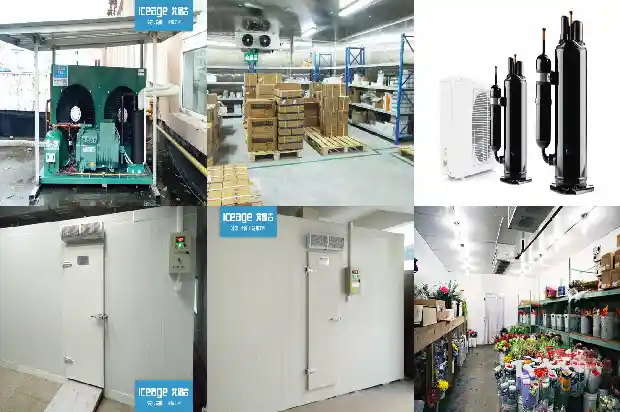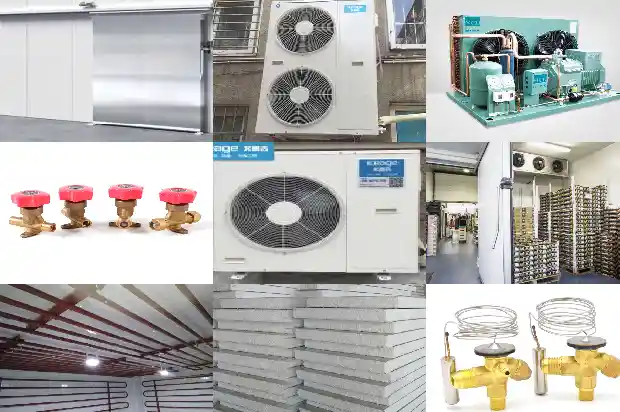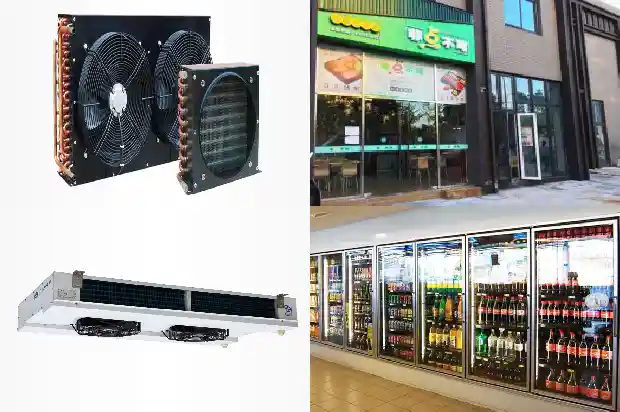Frosting and Defrosting Issues of Air - cooled Heat Pumps
2025-01-09
Causes of frosting:
Air-cooled heat pumps use ambient air as the cold source and thus have a strong environmental dependence. The lower the ambient temperature, the less heat the unit supplies. When the surface temperature of the outdoor evaporator fins is lower than the dew point temperature of water vapor, condensation water will be generated on its surface. If the ambient temperature is lower than 0 °C, frost will form on the evaporator surface.
Air-cooled heat pumps use ambient air as the cold source and thus have a strong environmental dependence. The lower the ambient temperature, the less heat the unit supplies. When the surface temperature of the outdoor evaporator fins is lower than the dew point temperature of water vapor, condensation water will be generated on its surface. If the ambient temperature is lower than 0 °C, frost will form on the evaporator surface.
Main factors affecting frosting:
- Outdoor temperature, humidity and air velocity.
- Fin spacing, number of tube rows along the air flow direction and fin surface roughness.

- In addition, the longer the unit runs, the easier it is to frost. The shorter the last start-stop time, the more likely the frosting tendency will be aggravated. The frosting phenomenon is more prominent during night operation.
- The overall structure of frost is divided into icicles, ice balls, ice layers and air bubbles.
Early stage of frosting:
- The surface of the frost layer is rough, increasing the heat exchange area.
- The cross-section of air circulation is reduced, the air velocity is increased, and the convective heat transfer coefficient on the air side is increased, strengthening the heat exchange.
Late stage of frosting:
- The deposition of frost on the evaporator surface will increase the thermal resistance.
- The accumulated frost will also increase the air resistance through the evaporator, causing the working point of the fan to deviate, thus reducing the air flow rate of the system and reducing the heat exchange capacity of the evaporator.
Final results:
- On the one hand, frosting increases the heat transfer resistance between air and refrigerant. On the other hand, the increase in frost thickness increases the air flow resistance, reduces the air flow rate and reduces the heat exchange capacity on the air side. Overall, the heat transfer effect and operation performance are reduced. When the frost increases to a certain thickness, the heat exchange capacity decreases rapidly.
- Experimental data shows that when the air flow rate of the outdoor heat exchanger decreases from 74 m³/min in the non-frosting state to 20 m³/min, the heat exchange capacity on the air side decreases by 20%.
Methods of defrosting:
- Electric heating method
- Reverse cycle defrosting method
- Hot gas bypass method
- Phase change heat storage device assisted defrosting
Electric heating tube:
Reverse cycle defrosting:
During defrosting, the compressor stops, the four-way reversing valve switches from the heating mode to the cooling mode, the compressor starts, and the heat pump unit changes from heating to cooling. The outdoor unit, which was originally an evaporator, becomes a condenser. The high-temperature and high-pressure gas output by the compressor directly enters the outdoor unit, releases heat into the frost layer, and then passes through the throttle valve to the indoor unit, producing a cooling effect at this time. After defrosting is completed, the mode is switched again to continue supplying heat to the room.
Reverse cycle defrosting:
During defrosting, the compressor stops, the four-way reversing valve switches from the heating mode to the cooling mode, the compressor starts, and the heat pump unit changes from heating to cooling. The outdoor unit, which was originally an evaporator, becomes a condenser. The high-temperature and high-pressure gas output by the compressor directly enters the outdoor unit, releases heat into the frost layer, and then passes through the throttle valve to the indoor unit, producing a cooling effect at this time. After defrosting is completed, the mode is switched again to continue supplying heat to the room.
Hot gas bypass method for defrosting:
The hot gas bypass method is an improved method based on the reverse cycle defrosting method. It can shorten the defrosting time, improve the defrosting efficiency and achieve better defrosting results.
Defrosting principle: Under the defrosting condition, the high-temperature and high-pressure gas output by the compressor directly passes through the electromagnetic defrosting valve to the outdoor unit for defrosting, and then directly returns to the gas-liquid separator and then to the compressor to form a small cycle. The differential defrosting thermostat is used to control defrosting. Two sensors respectively sense the coil temperature and the ambient temperature, and the temperature interpolation between the two controls the defrosting start temperature.
After the air conditioner enters the defrosting state, it is necessary to completely remove the frost layer at one time. Once the frost layer is not removed and the heating process is entered again, the remaining frost layer and defrosting water will quickly freeze into denser frost or ice. When the system enters the defrosting state again, it is difficult to remove the frost layer. To avoid this situation, monitor the evaporator temperature, the compressor return pipe temperature and the outdoor temperature, and require that the evaporation temperature is greater than 3 °C and the return pipe temperature is greater than 0 °C.
The hot gas bypass method is an improved method based on the reverse cycle defrosting method. It can shorten the defrosting time, improve the defrosting efficiency and achieve better defrosting results.
Defrosting principle: Under the defrosting condition, the high-temperature and high-pressure gas output by the compressor directly passes through the electromagnetic defrosting valve to the outdoor unit for defrosting, and then directly returns to the gas-liquid separator and then to the compressor to form a small cycle. The differential defrosting thermostat is used to control defrosting. Two sensors respectively sense the coil temperature and the ambient temperature, and the temperature interpolation between the two controls the defrosting start temperature.
After the air conditioner enters the defrosting state, it is necessary to completely remove the frost layer at one time. Once the frost layer is not removed and the heating process is entered again, the remaining frost layer and defrosting water will quickly freeze into denser frost or ice. When the system enters the defrosting state again, it is difficult to remove the frost layer. To avoid this situation, monitor the evaporator temperature, the compressor return pipe temperature and the outdoor temperature, and require that the evaporation temperature is greater than 3 °C and the return pipe temperature is greater than 0 °C.
Phase change heat storage device assisted defrosting: Using the phase change heat storage technology, a new type of heat storage device filled with DX40 phase change material plates is connected with the air source heat pump unit. Using the heat storage and release characteristics of the phase change heat storage device, the heat required for defrosting is compensated. While the heat pump unit supplies heat, the phase change heat storage device stores heat. When the heat pump unit is converted to the defrosting mode, the heat storage device releases heat to the air-conditioned room and assists in defrosting at the same time.
Defrosting principle: After reaching certain conditions (each air conditioner has been set at the factory: for example, the fin temperature is lower than the ambient temperature by X °C and lasts for X minutes), defrosting starts. At this time, the system changes to the cooling mode, the four-way valve exchanges the functions of the internal and external units, the refrigerant in the external unit is high-temperature and high-pressure Freon, which melts the ice. After reaching the set conditions, defrosting ends (the manufacturer has set it, generally the fin temperature of the external unit reaches X °C), and the system is changed to the cooling mode.
Defrosting principle: After reaching certain conditions (each air conditioner has been set at the factory: for example, the fin temperature is lower than the ambient temperature by X °C and lasts for X minutes), defrosting starts. At this time, the system changes to the cooling mode, the four-way valve exchanges the functions of the internal and external units, the refrigerant in the external unit is high-temperature and high-pressure Freon, which melts the ice. After reaching the set conditions, defrosting ends (the manufacturer has set it, generally the fin temperature of the external unit reaches X °C), and the system is changed to the cooling mode.
Idea 1: Prevent the water in the air from condensing or remove the water vapor in the air.
Idea 1: Spray the evaporator with circulating high-concentration brine.
Principle: When the water molecules in the air condense, they first reach the dew point and then liquefy. Once liquefied near the evaporator, they will immediately dissolve in the high-concentration brine. Because the brine has a high concentration, its freezing point is low.
Disadvantage: The concentration of the sprayed water is difficult to control and it may be necessary to add salt frequently.
Idea 1: Spray the evaporator with circulating high-concentration brine.
Principle: When the water molecules in the air condense, they first reach the dew point and then liquefy. Once liquefied near the evaporator, they will immediately dissolve in the high-concentration brine. Because the brine has a high concentration, its freezing point is low.

Disadvantage: The concentration of the sprayed water is difficult to control and it may be necessary to add salt frequently.
Idea 2: Dehumidify with desiccant.
Principle: Set a desiccant (such as CaO) at the air inlet of the evaporator in winter and other items that can react with water vapor to completely remove the water vapor in the heat exchange air, so that frosting will not occur. Moreover, if the desiccant is made into a belt-shaped detachable device, it should be very convenient to replace.
Disadvantage: An investment will be increased in the desiccant.
Principle: Set a desiccant (such as CaO) at the air inlet of the evaporator in winter and other items that can react with water vapor to completely remove the water vapor in the heat exchange air, so that frosting will not occur. Moreover, if the desiccant is made into a belt-shaped detachable device, it should be very convenient to replace.
Disadvantage: An investment will be increased in the desiccant.
Idea 2: The precipitation of ice is mainly caused by the fact that the heat exchange medium contains water. It is sufficient to replace the heat exchange medium with a medium that does not contain water.
Idea 4: Use cooling water circulation.
Principle: Add a condenser water circulation outside the refrigeration cycle. The medium of this cycle should not be water. It is best to use a medium that is stable near 0 °C and is incompatible with water and air.
Disadvantage: The volume is too large and the investment is high.
Idea 4: Use cooling water circulation.
Principle: Add a condenser water circulation outside the refrigeration cycle. The medium of this cycle should not be water. It is best to use a medium that is stable near 0 °C and is incompatible with water and air.

Disadvantage: The volume is too large and the investment is high.
Idea 5: Regional ground source heat pump or water source heat pump.
Ground source and water source can effectively solve the problem of icing. However, this form of air conditioner is suitable for centralized heating and a single user is unable to install it. Therefore, it is suitable for a community or a region to install a ground source heat pump heating unit.
Disadvantage: The initial investment is large and property management is required.
Ground source and water source can effectively solve the problem of icing. However, this form of air conditioner is suitable for centralized heating and a single user is unable to install it. Therefore, it is suitable for a community or a region to install a ground source heat pump heating unit.
Disadvantage: The initial investment is large and property management is required.
Related Articles
- Reasons for Frost Formation in Cold Storage and Defrosting Methods
- 10 Symptoms and Causes of Abnormal Frosting in Heat Pumps
- Fin Spacing Design of Cooler and Several Knowledge Points of Defrosting in Cold Storage
- Defrosting Operation Modes of Refrigeration Equipment and Its Control Components
- How to Calculate Refrigeration Load? And What Are the Issues?
- What Issues Should Be Noted in Cold Storage Installation and Construction?
- Can You Solve These 4 Common Issues of Industrial Chillers?
- Common Issues in Chiller Operation and Solutions
- Common Issues in Refrigeration Systems
- Common Issues with Refrigeration Equipment: What to Do?
- Common Issues to Pay Attention to During Cold Room Installation and Construction
- Introduction to the Components of a Cold Storage Unit and Common Issues in Cold Storage Units
- Influence of Fin Spacing of Evaporator in Air Cooler on Frost Formation
- Air - side Economizer
- Winter Approaches: How to Solve the Low High - pressure Issue of Air - cooled Condensing Units?
- What Are the Common Causes of Cold Air Blower Noise?
- How to Troubleshoot and Repair High - pressure Protection of Air - cooled Units?
- What Exactly Are the Ten Typical Malfunctions of Air Conditioners?
